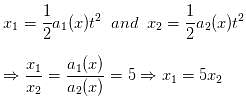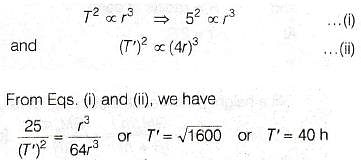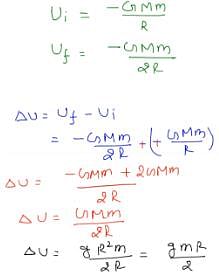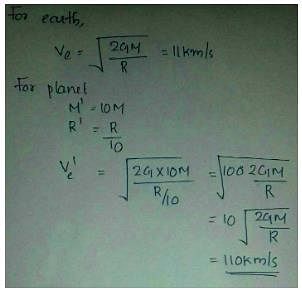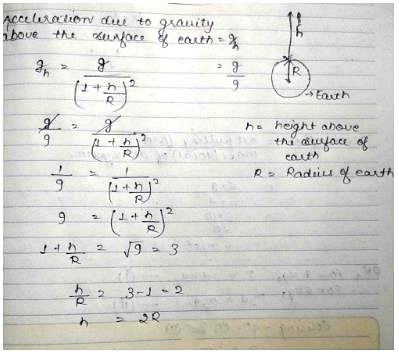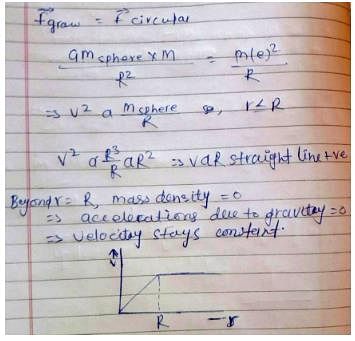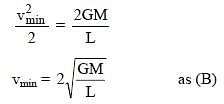NEET Previous Year Questions: Gravitation - NEET MCQ
30 Questions MCQ Test Physics Class 11 - NEET Previous Year Questions: Gravitation
If suddenly the gravitational force of attraction between earth and a satellite revolving around it becomes zero, then the satellite will
[AIEEE 2002]
The escape velocity of a body depends upon mass as
[AIEEE 2002]
| 1 Crore+ students have signed up on EduRev. Have you? Download the App |
The kinetic energy needed to project a body of mass m from the earth's surface (radius R) to infinity is
[AIEEE 2002]
Energy required to move a body of mass m from an orbit of radius 2R to 3R is
[AIEEE 2002]
The escape velocity for a body projected vertically upwards from the surface of earth is 11 km/s. If the body is projected at an angle of 45° with the vertical, the escape velocity will be
[AIEEE 2003]
Two spherical bodies of mass M and 5M and radii R and 2R respectively are released in free space with initial separation between their centres equal to 12R. If they attract each other due to gravitational force only. then the distance covered by the smaller body just before collision is
[AIEEE 2003]
The time period of a satellite of earth is 5 h. If the separation between the earth and the satellite is increased to 4 times the previous value, the new time period will become
[AIEEE 2003]
Suppose the gravitational forces varies inversely as the nth power of distance. Then the time period of a planet in circular orbit of radius R around the sun will be proportional to
[AIEEE 2004]
If g is the acceleration due to gravity on the earth's surface, the gain in the potential energy of an object of mass m raised from the surface of the earth to a height equal to the radius R of the earth, is
[AIEEE 2004]
The time period of an earth satellite in circular orbit is independent of
[AIEEE 2004]
A satellite of mass m revolves around the earth of radius R at a height x from its surface. If g is the acceleration due to gravity on the surface of the earth, the orbital speed of the satellite is
[AIEEE 2004]
A particle of mass 10 g is kept on the surface of a uniform sphere of mass 100 kg and radius 10 cm. Find the work to be done against the gravitational force between them, to take the particle far away from the sphere, (you may take G = 6.67 × 10-11 Nm2/kg-2)
[AIEEE 2005]
The change in the value of g at a height h above the surface of the earth is the same as at a depth d below the surface of earth. When both d and h are much smaller than the radius of earth, then which one of the following is correct ?
[AIEEE 2005]
Average density of the earth
[AIEEE 2005]
If gE and gM are the accelerations due to gravity on the surfaces of the earth and the moon respectively and if Millikan's oil drop experiment could be performed on the two surfaces, one will find the ratio to be
[AIEEE 2007]
Statement I : For a mass M kept at the centre of a cube of side a, the flux of gravitational field passing through its sides is 4p GM.
and
Statement II : If the direction of a field due to apoint source is radial and its dependence on the distance r from the source is given as its flux through a closed surface depends only on the strength of the source enclosed by the surface and not on the size or shape of the surface.
[AIEEE 2008]
A planet in a distant solar system is 10 times more massive than the earth and its radius is 10 times smaller. Given that the escape velocity from the earth is 11kms-1, the escape velocity from the surface of the planet would be
[AIEEE 2008]
The height at which the acceleration due to gravity becomes g/9 (where g = the acceleration due to gravity on the surface of the earth) in terms of R, the radius of the earth is
[AIEEE 2009]
Two bodies of masses m and 4 m are placed at a distance r. The gravitational potential at a point on the line joining them where the gravitational field is zero, is
[AIEEE 2011]
Two particles of equal mass m go around a circle of radius R under action of their mutual gravitational attraction. The speed of each particle with respect to their centre of mass is
[AIEEE 2011]
The mass of a spaceship is 1000kg. It is to be launched from the earth's surface out into free space. The value of g and R (radius of earth) are 10 m/s2 and 6400 Km respectively. The required energy for this work will be
[AIEEE 2012]
What is the minimum energy required to launch a statellite of mass m from the surface of a planet of mass M and radius R in a circular orbit at an altitude of 2R?
[JEE MAIN 2013]
In a region of only gravitational field of mass `M' a particle is shifted from A to B via three different paths in the figure. The work done in different paths are W1, W2, W3 respectively then
[JEE' (Scr.) 2003]
What is the minimum energy required to launch a satellite of mass m from the surface of a planet of mass M and radius R in a circular orbit at an altitude of 2R?
A system of binary stars of masses mA and mB are moving in circular orbits of radii rA and rB respectively. If TA and TB are the time periods of masses mAand mB respectively, then
[JEE 2006]
A spherically symmetric gravitational system of particles has a mass density
where r0 is a constant. A test mass can undergo circular motion under the influence of the gravitational field of particles. Its speed V as a function of distance r (0 < r < ∞) from the centre of the system is represented by
[JEE 2008]
STATEMENT-1
An astronaut in an orbiting space station above the Earth experiences weightlessness.
and
STATEMENT-2
An object moving around the Earth under the influence of Earth's gravitaitonal force is in a state of `free-fall'.
[JEE 2008]
Gravitational acceleration on the surface of a planet is where g is the gravitational acceleration on the surface of the earth. The average mass density of the planet is 2/3 times that of the earth. If the escape speed on the surface of the earth is taken to be 11 kms-1, the escape speed on the surface of the planet in kms-1 will be
[jee 2010]
Two spherical planets P and Q have the same uniform density , masses Mpand MQ, and surface areas A and 4A, respectively. A spherical planet R also has uniform density and its mass is (MP + MQ). The escape velocities from the planets P, Q and R, are Vp, VQ and VR,respectively. Then
[jee 2012]
Two bodies, each of mass M, are kept fixed with a separation 2L. A particle of mass m is projected from the midpoint of the line joining their centres, perpendicular to the line. The gravitational constant is G. The correct statement(s) is (are)
[jee 2013]
|
97 videos|382 docs|103 tests
|







